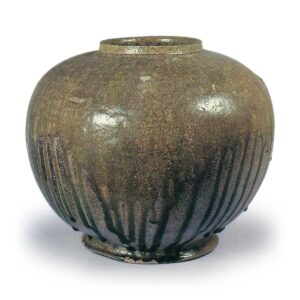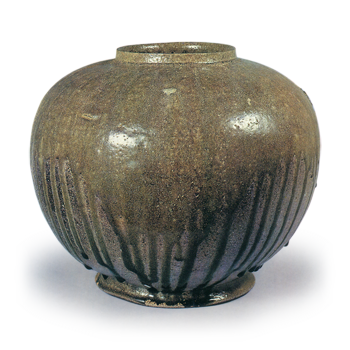
9th century
Height 25.6cm, mouth diameter 12.2cm, body diameter 30.7cm, bottom diameter 17.2cm
Important Cultural Property
Fukuoka City Museum of Art
The low rise of the neck, the small size of the mouth, the spherical body that has lost its shoulder tension, and the low, but still powerful, base of the stand suggest that this jar was made in the first half of the ninth century. It is made of highly refractory clay with a slight iron content and shows excellent wheel-thrown molding. The high firing rate has caused some distortions in the firing of the base, but the overall firing is extremely good. The ash glaze, which covered the entire surface from the neck to the shoulder, cascaded down the lower half of the body and partially reached the base, giving this jar a powerful impression. The fire color of the base, which appears between the glazes, indicates that this jar was made at the Sanage kiln in Aichi Prefecture. This jar is generally known as a “natural glazed rain jar,” but a simple natural glaze would not cover the entire surface from the neck to the shoulder as beautifully as this. At the Sanage kiln during this period, Buddhist vessels such as water jars and purification vases, as well as large short-necked vases like this one, were almost exclusively glazed with primitive ash glaze. The ash glaze is not applied to the entire surface of the vessel, but is usually applied to the neck of the mouth and part of the body from the shoulder to the body. This is probably one of the best examples of ash-glazed short-necked vases from the Sanage kiln.



